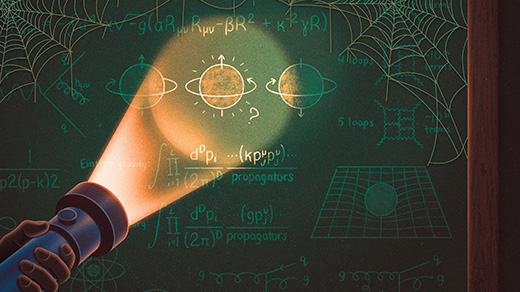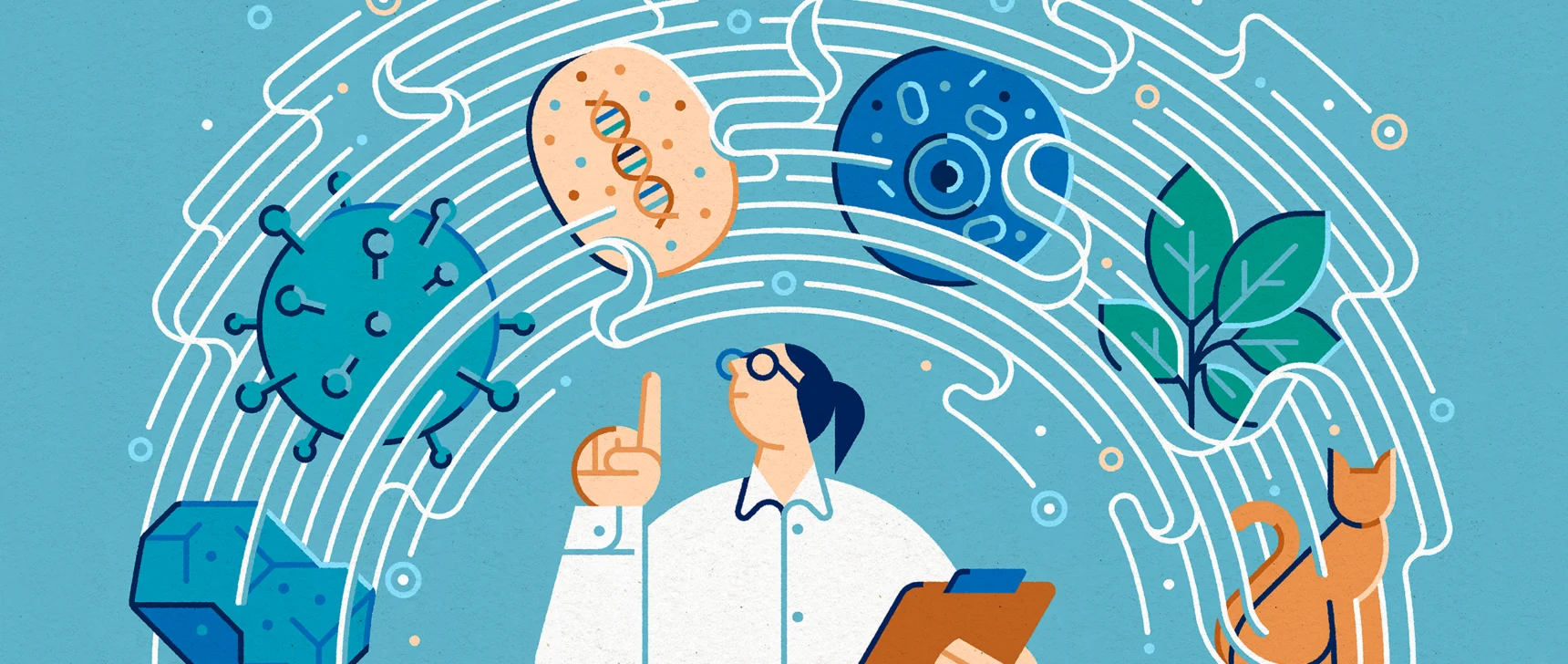Particle Physicists Detect ‘Magic’ at the Large Hadron Collider

Celsius Pictor for Quanta Magaizne
Introduction
Ninety million times a year, when protons crash together at the Large Hadron Collider (LHC), they produce, in their wreckage, a top quark and an anti-top quark, the heaviest known elementary particles. In the trillionth of a trillionth of a second before the particles decay into lighter pieces, they fly apart. But they remain quantum mechanically entangled, meaning each particle’s state depends on the other’s. If the top quark is measured to spin in one direction, the anti-top quark must spin the opposite way.
Top quarks are special. Other types of quarks quickly group together to form composite particles (such as neutrons) before the LHC’s detectors can record their states. But top quarks decay before combining with other quarks. The particles they decay into contain a record of their spins — an observable fingerprint of their entanglement.
The ATLAS experiment at the LHC measured the correlations between top and anti-top quarks for the first time in 2023. A cascade of further entanglement measurements have followed.
Such efforts are new inside the walls of the LHC. Seventeen years after the machine switched on, particle physicists are realizing that they can use the collider to explore how information flows through quantum systems — a question at the foundations of quantum computing. The two possible spins of the quarks correspond to the 0 and 1 states of a qubit, a unit of quantum information. “It is treating the process of colliding things together and forming new particles as a quantum processor,” said Alan Barr, a physicist at the University of Oxford who works on the ATLAS experiment. “You can investigate a whole different set of questions that colliders were not really designed to do in the first place but are very capable of addressing.”
This convergence of quantum information theory and particle physics “really is an emergent field,” said Regina Demina, a physicist at the University of Rochester who works on the CMS experiment at the LHC. “It’s like a gold rush right now.
One buzzy result came this spring, when the CMS experiment measured the “magic” of a pair of top quarks. In quantum information theory, magic is a property of entangled qubits that makes their state difficult to simulate on a classical computer. For quantum computers to run algorithms faster than classical computers can, they must be fed a supply of magic states as a kind of fuel.
“People seem to be saying, ‘We just want to find any quantum system where magic is there in nature, so that we can study the properties of magic,’” said Martin White, a physicist at the University of Adelaide who proposed the magic top quark measurement along with Chris White, his identical twin, last year. “This is adding to that list.”
A Little Bit of Magic
Quantum computers can run certain algorithms exponentially faster than regular computers. This speedup is possible in part because of entanglement, which links the 0 and 1 states of different qubits, creating a network of contingent possibilities. The quantum computer can manipulate all the possible states at once, rather than one after another.
High levels of entanglement between qubits used to be thought of as a surefire way to give quantum computers a performance advantage. “Intuition would make you think, the more entanglement we have, the better our quantum computer is,” said Chris White, of Queen Mary University of London. However, he said, “that actually turns out to be completely false.”
In the 1990s, a quantum information breakthrough came in the proof of the Gottesman-Knill theorem. The theorem revealed that certain highly entangled quantum states — called stabilizer states — can be simulated just as efficiently on a classical computer as it can on a quantum computer. Create these states out of qubits, and you won’t find any speedup at all.
In search of quantum advantage — the ability of a quantum computer to outperform classical computers on certain tasks — physicists began to look for entangled states that differed as much as possible from stabilizer states. These states earned the name magic states. (“It’s an appalling word,” said Martin White, but after 20 years, there’s probably no changing it now.)
In 2014, physicists found the missing piece that gives magic states their quantum boost. The key is contextuality — a lesser-known feature of quantum mechanics. Contextuality says that the outcome of a quantum measurement will depend on the other properties that are being measured at the same time. The measured properties aren’t fixed and waiting to be discovered; they’re contextual. Stabilizer states are an exception to the rule — it’s possible to treat them as noncontextual and imagine that they have a full set of definite properties at any given time. But for magic states, there’s no getting around their contextuality, making them hard to simulate classically.


Particle physicists Martin White (top) of the University of Adelaide in Australia and Chris White of Queen Mary University of London have always wanted to work together. Last year, the identical twins finally did so, proposing a way to detect the magic of top quarks.
Luca Bastians (top); Andreas-Brandhuber
Particle physicists Martin White (left) of the University of Adelaide in Australia and Chris White of Queen Mary University of London have always wanted to work together. Last year, the identical twins finally did so, proposing a way to detect the magic of top quarks.
Luca Bastians (left); Andreas-Brandhuber
Quantum information researchers began looking for ways to generate and enhance magic in quantum systems. This caught the attention of a few particle physicists — including Martin and Chris White — who wondered how magic appears in systems of elementary particles. “We thought, the LHC is a quantum system. Top quarks are a quantum system. Can we look at that system and just see if it’s magic or not?” Chris White said.
They proposed a way to do so in late 2024. The paper is their first collaboration. “I found it really quite emotional when it was released. We wanted to work together for many years,” Martin White said.
When Demina met the brothers at a conference, they inspired her to bring the proposal to her group at CMS. “They are identical twins, and one works in the U.K., and the other one works in Australia. They were moved very far apart, but are still in an entangled state,” she mused.
To glean the magic of top quarks, CMS analyzed a huge bank of collision data, tallying the spins of top quark pairs that flew off in all different directions. Doing this allowed the team to fill out a so-called spin correlation matrix, a complete description of the correlations between the particles’ spins in the x, y, and z directions. From this matrix, physicists calculate magic.
The entangled quark pairs did indeed have magic. CMS’s measurement marked the entry of the once-niche quantum computing concept into the realm of particle physics.
The main point of studying magic is to potentially improve quantum computers rather than reveal new insights about elementary particles. But the sensitive methods developed for doing such a detailed measurement led to something unexpected: The physicists observed that the top quark and anti-top quark were sometimes extra-entangled. In these cases, the quarks were binding strongly to form a single particle, an elusive state called toponium. Toponium was predicted in 1990 but “was thought to be a too-subtle effect” for a collider such as the LHC to see, said Marcel Vos, a leader of the top quark research group at ATLAS.
CMS and ATLAS posted their measurements of toponium in March and July, respectively. “That’s our first tangible spin-off from all this,” Vos said.
Threads To Pull
What some physicists find exciting about the new overlap between particle physics and quantum information theory is the chance to use the LHC to probe subtle questions about entanglement.
For instance: “What happens to your entangled system after the top quark decays? Will the daughters of the top quark still be entangled with the anti-top quark?” Vos asked. “Quantum field theory says they should be, but no one’s ever tested it.”
The experiments might also offer new insights about the quantum-to-classical transition — how a quantum object goes from an uncertain state to a single definite state. This famously happens when a quantum object is measured, but in this case, the mystery crops up when the top quark decays into lighter particles. Initially, the quark is in an uncertain state of both possible spin directions at once. When it decays, the quark appears to choose one spin direction, and the particles it generates travel in certain directions based on that choice of spin. It’s as if the top quark is forced to “measure” its own spin during its decay. “Mathematically, it’s an equivalent process to making a measurement,” Barr said. That gives physicists a fresh angle on the quantum-to-classical transition.
Demina hopes to probe questions about time. “There is a certain theory that suggests that time is not a fundamental property of nature, but it is an emergent property,” she said. One famous mechanism for how this can work was described by Don Page and William Wootters in 1983. They argued that the universe as a whole may be timeless and unchanging, while observers inside the universe can perceive temporal evolution. This perception arises because various possible spatial configurations are entangled with the spatial configurations of an object with some periodic pattern, like the hands of a clock. The effect was demonstrated with photons in 2013. “My dream is to perform this experiment in a system of elementary particles, to demonstrate the Page-Wootters mechanism,” Demina said.
Others have raised concerns that these top quark experiments cannot reliably test quantum mechanics at all. Herbert Dreiner, a physicist from the University of Bonn in Germany, argued in two recent preprints that the approach is circular: To measure entanglement, you need to relate the angular motion of the outgoing decay products to the top and anti-top quarks’ spins. But “in order to translate one into the other, you have to use some theory,” Dreiner said. “And if you’re using quantum mechanics, you can’t test for quantum mechanics.”
That debate is ongoing. To some, this whole line of experimentation is a sign that, after 17 years of collision experiments at the LHC, new goals are needed. “There is a sense that you’re always looking for new things to do,” Martin White said.
“There is a lot of skepticism,” Vos said. Still, “you start pulling on the thread, and you don’t know what you’re going to come up with.”



